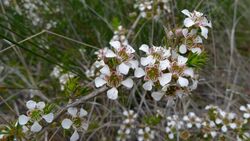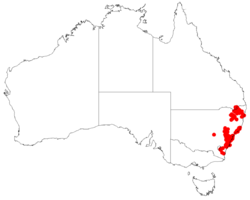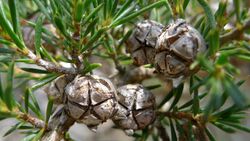Biology:Leptospermum arachnoides
| Spidery tea-tree | |
|---|---|

| |
| Flowers of Leptospermum arachnoides in the Royal National Park | |
| Scientific classification | |
| Kingdom: | Plantae |
| Clade: | Tracheophytes |
| Clade: | Angiosperms |
| Clade: | Eudicots |
| Clade: | Rosids |
| Order: | Myrtales |
| Family: | Myrtaceae |
| Genus: | Leptospermum |
| Species: | L. arachnoides
|
| Binomial name | |
| Leptospermum arachnoides Gaertn.[1]
| |

| |
| Occurrence data from AVH | |
| Synonyms[1] | |
| |
Leptospermum arachnoides, commonly known as the spidery tea-tree,[2] is a species of shrub that is endemic to eastern Australia. It has rough bark, crowded linear to lance-shaped leaves with a sharp point on the end, white flowers and hairy fruit.
Description
Leptospermum arachnoides is a slender, spreading shrub that typically grows to 1–2 m (3 ft 3 in–6 ft 7 in) high and 1.5 m (4 ft 11 in) wide and has rough, peeling, flaky bark. The leaves are linear to lance-shaped or elliptical, mostly 10–20 mm (0.39–0.79 in) long, 1–3 mm (0.039–0.118 in) wide, concave in cross-section, with a sharp point on the end and on a very short but broad petiole. The flowers are borne singly in leaf axils and are 8–10 mm (0.31–0.39 in) in diameter with a hairy floral cup about 2 mm (0.079 in) long. The sepals are about 2 mm (0.079 in) long and hairy, the petals about 4 mm (0.16 in) long and white, the stamens are about 2 mm (0.079 in) long. Flowering occurs from November to January and the fruit is a hairy capsule 5–8 mm (0.20–0.31 in) in diameter.[2][3][4][5]
Taxonomy and naming
Leptospermum arachnoides was first formally described in 1788 by Joseph Gaertner in his book De Fructibus et Seminibus Plantarum.[6][7] The specific epithet (‘’arachnoides’’) is derived from Latin, meaning "resembling a spider".[2]
Distribution and habitat
Spidery tea-tree grows in moist heath and sclerophyll forest, usually on shallow soils derived from sandstone and granite. It occurs between south-east Queensland and the Tinderry Range in New South Wales.[3]
References
- ↑ 1.0 1.1 "Leptospermum arachnoides". https://biodiversity.org.au/nsl/services/apc-format/display/80868. Retrieved 19 March 2020.
- ↑ 2.0 2.1 2.2 Les Robinson – Field Guide to the Native Plants of Sydney, ISBN:978-0-7318-1211-0 page 52
- ↑ 3.0 3.1 "Leptospermum arachnoides". Royal Botanic Garden Sydney. http://plantnet.rbgsyd.nsw.gov.au/cgi-bin/NSWfl.pl?page=nswfl&lvl=sp&name=Leptospermum~arachnoides. Retrieved 19 March 2020.
- ↑ "Leptospermum arachnoides". Australian National Botanic Gardens. https://www.anbg.gov.au/leptospermum/leptospermum-arachnoides.html. Retrieved 19 March 2020.
- ↑ Carolin, Roger C.; Tindale, Mary D. (1993). Flora of the Sydney region (4th ed.). Reed. p. 395. ISBN 0730104001.
- ↑ "Leptospermum arachnoides". APNI. https://id.biodiversity.org.au/instance/apni/497009. Retrieved 19 March 2020.
- ↑ Gaertner, Joseph (1788). De Fructibus et Seminibus Plantarum (Volume1). Stuttgart: Sumtibus Auctoris, Typis Academiae Carolinae. p. 174. https://www.biodiversitylibrary.org/item/114363#page/372/mode/1up. Retrieved 19 March 2020.
Wikidata ☰ Q15368856 entry
 |


